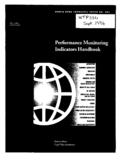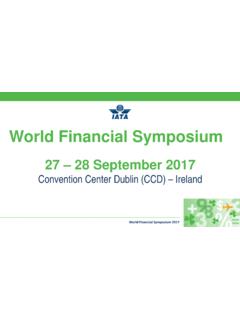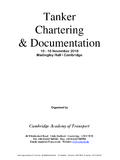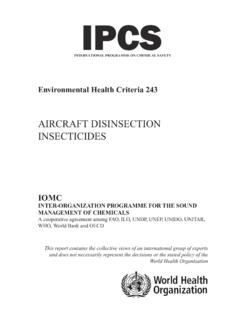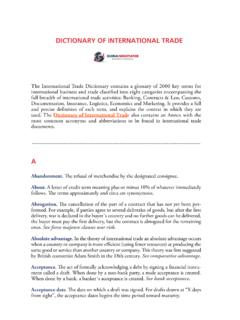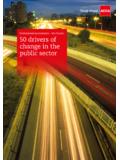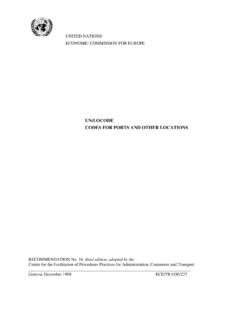Transcription of Department for International Development - World Bank
1 Department for InternationalDevelopmentWorld bank Urban transport Strategy Review -Mass Rapid Transit in Developing CountriesFinal ReportJuly 2000 Halcrow Foxin association with Traffic and TransportConsultantsHalcrow FoxVineyard House 44 Brook Green London W6 7 BYTel +44 (0)20 7603 1618 Fax +44 (0)20 7603 Fox has prepared this report in accordance with theinstructions of their client, , for their sole and specific use. Any otherpersons who use any information contained herein do so at theirown risk. Halcrow Group Limited 2000 Department for InternationalDevelopmentWorld bank Urban transport Strategy Review Mass Rapid Transit in Developing CountriesFinal ReportJuly 2000 Halcrow Foxin association with Traffic and TransportConsultantsHalcrow FoxVineyard House 44 Brook Green London W6 7 BYTel +44 (0)20 7603 1618 Fax +44 (0)20 7603 is the back page of the text is hidden text and will Amendment RecordThis report has been issued and amended as follows.
2 IssueRevisionDescriptionDateSigned10 Draft14/4 RJA111/5 RJA2 Draft Final26/5 RJA3 Comments 119/7 RJA4 Final27/7 RJAiContentsPage Rapid Impacts on Policy in Project of the MRT Rapid Impacts on Policy in Project of the MRT of the Report62 Public of Public Travel Options133 MRT Activity in Developing Need for Appropriate Affecting Future Busway Incremental Change524 MRT and City System and City Metro UMTA Bus Priority Systems LRT of Private Sector BOT Projects73 BDIAGNOSIS766 Scale of Major as for the Private to for MRT Development858 Forecasting MRT of of Poor Approach899 Planning for of Modifying MRT after Private Sector Development Development and Build MRT - Privatisation of Existing Systems11211 Affordability and the Private Forecasts, Outturn and of Government Role for the Public of the Private Sector12512 Public transport Systems IMPACTS13513 Economic and Metro Research of 1990 Research Conclusions14014 Poverty from Economic MRT of MRT Policy on Pollution and Direct Effects of MRT Distortion of Public Sector Use and City Research Impacts: Bus-Based Impacts.
3 Rail Systems175 DAPPROACH17718 MRT Potential MRT Alignment and and Management of Competitive Bids and Operations204 ANNEXES206 AReferences206 BAcknowledgements209 TablesPage The MRT Regional MRT Characteristics of the Travel Metro Costs from 1990 Factors Influencing Metro Capital Metro Costs in ITA Metro Typical Costs for New-Build Results of the 1990 Metro Metro Expectations and Key Results of the USA UMTA Transit Selected MRT Systems Key MRT Infrastructure Concessions in Key Characteristics of Metro MRT Concessions Metro Projects: Forecasts and Characteristics of Expressway and Metro Metro Perceptions of BOT MRT Metro Integration Measures Tariff Integration Metro Inputs to Re-Evaluation of Case Study Ridership Forecasts and Observed Patronage for Case Study Probable Impact of Metro Concessions on the The Impacts of Metro Vertical Alignment BOT Metros Risk Allocation204 GlossaryAVLA utomatic Vehicle LocationBLTB uild Lease TransferBOOB uild own OperateBOTB uild Operate TransferCBDC entral Business DistrictCNGC ompressed Natural GasDFIDD epartment for International DevelopmentDBOMD esign Build Operate MaintainFSUF ormer Soviet UnionIRRI nternal Rate of ReturnITInformation TechnologyITA International Tunnelling AssociationKLKuala LumpurLNGL iquefied Natural GasLRTL ight Rail TransitMRTMass Rapid TransitNMTNon Motorised TransportPphpdPassengers per hour.
4 Per directionAbstractThis position paper provides an input to the World bank Urban transport Strategy Review. It considers theappropriate role for Mass Rapid Transit (MRT) in developing and transitional economies. MRT is defined toinclude bus and rail-based systems busways, LRT, metros and suburban rail. The paper is based on theauthors experience, together with contributions from correspondents and comments form the World bank ,and DFID who financed the work. It reviews available experience and research, identifies the sector issues, and assesses what is known aboutthe impact of the MRT options on government s policy objectives; particular emphasis is placed on thepotential of MRT policy to alleviate poverty. The paper considers the factors influencing the choice ofsystem, and how projects should subsequently be developed and implemented. It suggests an approach to theidentification and Development of MRT options. The main findings are brought together in the first SynthesisChapter of the position paper provides a review of the role and nature of MRT (Mass RapidTransit) systems in developing and transitional economies, based upon the authors experience and comments from the World bank and DFID.
5 A companion paperreviews public transport competition, and how competitive markets can best servepublic policy purpose is to review available experience, examine the processes by which MRTsystems can impact upon public policy, identify the issues in project Development , andinsofar as this is possible provide guidance in addressing two decisions: The choice of MRT system, and Given this decision, how to approach the issues which should be consideredduring the project Development process, to maximise the prospects for role and form of MRT of course depends upon the city context, its size, incomelevel, asset base, institutions and the characteristics of its public transport upon these are cultural and behavioural factors and attitudes, all ofwhich may be is a broad recognition that MRT needs to be developed as part of acomprehensive land use and transport strategy, and that its potential benefits will bemuch enhanced when it forms a central part of a package of measures.
6 It isparticularly important that targeted restraints on private car use are introduced, torealise its potential in shifting policy towards a less car-dependant urban impacts upon the following public policy areas: The macro-economy effects, particularly in the case of metros whose call onresources is large relative to national and city resources Economic growth, which results in increased incomes and benefits for society Poverty alleviation, and impacts upon the travel-disadvantaged (including theencumbered, frail and disabled) The environment, both directly and long-term, and Land use and Development , both immediate and through long-term changes tothe structure of the cityThe central question is how MRT should be applied to secure the balance of impacts,which best give effect to government s overall has been a desk-based exercise, which has sought to bring together the availableinformation and experience, and applied it within a clear framework.
7 The subjectmatter is one in which strong views are sometimes held and we have sought toprovide an objective analysis, so far as possible based upon fact and realism. Whathappens in practice is often as much the product of political attitudes and imperativesas technical analysis, and we have sought to understand the overall context. But factsare often few, and much is required to remedy the existing absence of knowledge andunderstanding in the synthesis first draws a simple classification for MRT systems, and identifies thereal options available to decision-makers, their similarities and their defining then summarises what we know about their impacts upon the above four policyareas, and highlights the conflicts at the heart of MRT policy, which can beproblematic. The following section considers the key issues, which affect projectdevelopment, and how we might best approach these. We then draw things together,by considering what we know about the applicability of MRT Rapid core requirement of mass transit in developing cities is that it carries largenumbers of passengers, rapidly.
8 Given public funding constraints this usually requiresfares, which are not low, and given the need to attract a mass ridership, fares cannotbe high either. Speed is critical to securing its impacts; hence the terms mass rapidtransit is used in this literature is full of attempts to categorise these modes, and there is no single right answer. They may be categorised in terms of their technology, right-of-wayexclusivity, grade-separation, guidance and operational regimes. There is a large rangeof possibilities in practice. We have reviewed the MRT systems actually operating indeveloping cities and categorised them by technology and degree of segregation,which broadly translate into level of service, capacity and generic forms of mass transit currently exist in major cities, which we define asfollows: Busways these are generally segregated sections of roadway within majorcorridors, with horizontal protection from other traffic, and priority over othertraffic at junctions, which are generally signalised Light rail transit (LRT) this is at-grade, with similar horizontal protection tobusways Metros these are fully segregated, usually elevated or underground.
9 It is thesegregation that is critical to providing a rapid service, and the technology thatallows a high mass ridership to be carried3S Suburban rail these services are usually physically part of a larger railnetwork, usually at-grade and fully-segregated incorporating road-railsegregation or controlled MRT systems have much in common. They utilise a right-of-way, which allowsoperations to be optimised. They are systems, which comprise several elements(vehicles, track, control systems, stops, operational plans), that need to be optimisedone with the other to achieve high performance. They need to be coordinated withfeeder bus/ paratransit services; and they need institutional coordination forimplementation, and regulation to secure the public also have major defining features, notably in respect to: Use of space busways usually involve reallocation of existing roadspace, LRToften does the same, but may also add new capacity, when using former railalignments for example.
10 Metros add new capacity, typically increasing thepassenger-carrying capacity of a major corridor by a factor of 3 (they may haveno impact on road capacity, or if elevated lead to a small reduction) Integration - all systems require interchange to provide an integrated publictransport system. Rail systems, and busways operating trunk-and-feeder services require more interchange Capacity. Busways, depending on specification, have a practical capacity of 10 -20,000 passengers per hour per direction (pphpd), or occasionally higher. Thereare no examples of LRT carrying flows in excess of 10,000 pphpd, and there isreason to doubt whether they can achieve much higher flows. Metros bycomparison carry very large passenger volumes 60,000 pphpd or higher; andhigh-specification suburban rail can typically carry 30,000 pphpd. Level of service. Rail systems can generally provide a high quality ride, and whensegregated, regularity. Bus systems perform less well in these respects.











